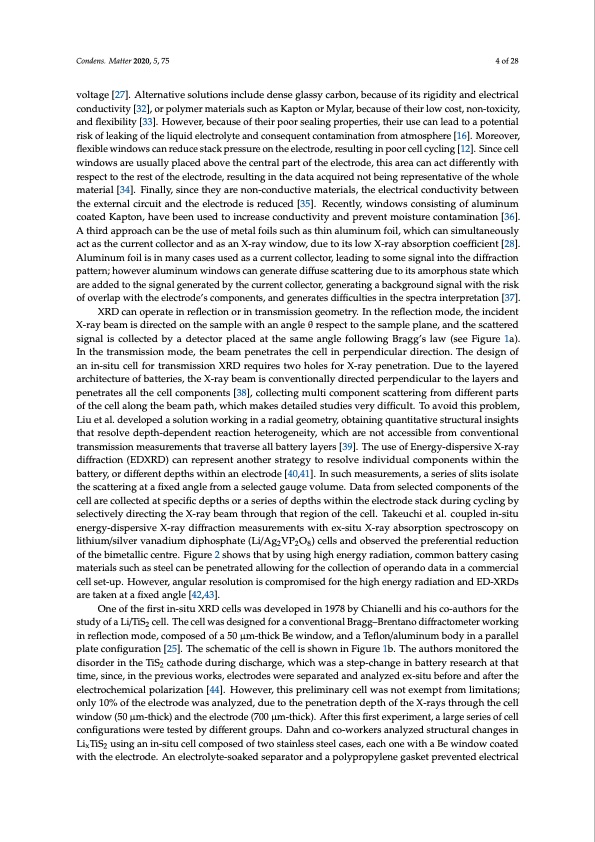
PDF Publication Title:
Text from PDF Page: 004
Condens. Matter 2020, 5, 75 4 of 28 voltage [27]. Alternative solutions include dense glassy carbon, because of its rigidity and electrical conductivity [32], or polymer materials such as Kapton or Mylar, because of their low cost, non-toxicity, and flexibility [33]. However, because of their poor sealing properties, their use can lead to a potential risk of leaking of the liquid electrolyte and consequent contamination from atmosphere [16]. Moreover, flexible windows can reduce stack pressure on the electrode, resulting in poor cell cycling [12]. Since cell windows are usually placed above the central part of the electrode, this area can act differently with respect to the rest of the electrode, resulting in the data acquired not being representative of the whole material [34]. Finally, since they are non-conductive materials, the electrical conductivity between the external circuit and the electrode is reduced [35]. Recently, windows consisting of aluminum coated Kapton, have been used to increase conductivity and prevent moisture contamination [36]. A third approach can be the use of metal foils such as thin aluminum foil, which can simultaneously act as the current collector and as an X-ray window, due to its low X-ray absorption coefficient [28]. Aluminum foil is in many cases used as a current collector, leading to some signal into the diffraction pattern; however aluminum windows can generate diffuse scattering due to its amorphous state which are added to the signal generated by the current collector, generating a background signal with the risk of overlap with the electrode’s components, and generates difficulties in the spectra interpretation [37]. XRD can operate in reflection or in transmission geometry. In the reflection mode, the incident X-ray beam is directed on the sample with an angle θ respect to the sample plane, and the scattered signal is collected by a detector placed at the same angle following Bragg’s law (see Figure 1a). In the transmission mode, the beam penetrates the cell in perpendicular direction. The design of an in-situ cell for transmission XRD requires two holes for X-ray penetration. Due to the layered architecture of batteries, the X-ray beam is conventionally directed perpendicular to the layers and penetrates all the cell components [38], collecting multi component scattering from different parts of the cell along the beam path, which makes detailed studies very difficult. To avoid this problem, Liu et al. developed a solution working in a radial geometry, obtaining quantitative structural insights that resolve depth-dependent reaction heterogeneity, which are not accessible from conventional transmission measurements that traverse all battery layers [39]. The use of Energy-dispersive X-ray diffraction (EDXRD) can represent another strategy to resolve individual components within the battery, or different depths within an electrode [40,41]. In such measurements, a series of slits isolate the scattering at a fixed angle from a selected gauge volume. Data from selected components of the cell are collected at specific depths or a series of depths within the electrode stack during cycling by selectively directing the X-ray beam through that region of the cell. Takeuchi et al. coupled in-situ energy-dispersive X-ray diffraction measurements with ex-situ X-ray absorption spectroscopy on lithium/silver vanadium diphosphate (Li/Ag2VP2O8) cells and observed the preferential reduction of the bimetallic centre. Figure 2 shows that by using high energy radiation, common battery casing materials such as steel can be penetrated allowing for the collection of operando data in a commercial cell set-up. However, angular resolution is compromised for the high energy radiation and ED-XRDs are taken at a fixed angle [42,43]. One of the first in-situ XRD cells was developed in 1978 by Chianelli and his co-authors for the study of a Li/TiS2 cell. The cell was designed for a conventional Bragg–Brentano diffractometer working in reflection mode, composed of a 50 μm-thick Be window, and a Teflon/aluminum body in a parallel plate configuration [25]. The schematic of the cell is shown in Figure 1b. The authors monitored the disorder in the TiS2 cathode during discharge, which was a step-change in battery research at that time, since, in the previous works, electrodes were separated and analyzed ex-situ before and after the electrochemical polarization [44]. However, this preliminary cell was not exempt from limitations; only 10% of the electrode was analyzed, due to the penetration depth of the X-rays through the cell window (50 μm-thick) and the electrode (700 μm-thick). After this first experiment, a large series of cell configurations were tested by different groups. Dahn and co-workers analyzed structural changes in LixTiS2 using an in-situ cell composed of two stainless steel cases, each one with a Be window coated with the electrode. An electrolyte-soaked separator and a polypropylene gasket prevented electricalPDF Image | Synchrotron-Based X-ray Diffraction for Lithium-Ion Batteries

PDF Search Title:
Synchrotron-Based X-ray Diffraction for Lithium-Ion BatteriesOriginal File Name Searched:
condensedmatter-05-00075.pdfDIY PDF Search: Google It | Yahoo | Bing
Sulfur Deposition on Carbon Nanofibers using Supercritical CO2 Sulfur Deposition on Carbon Nanofibers using Supercritical CO2. Gamma sulfur also known as mother of pearl sulfur and nacreous sulfur... More Info
CO2 Organic Rankine Cycle Experimenter Platform The supercritical CO2 phase change system is both a heat pump and organic rankine cycle which can be used for those purposes and as a supercritical extractor for advanced subcritical and supercritical extraction technology. Uses include producing nanoparticles, precious metal CO2 extraction, lithium battery recycling, and other applications... More Info
| CONTACT TEL: 608-238-6001 Email: greg@infinityturbine.com | RSS | AMP |